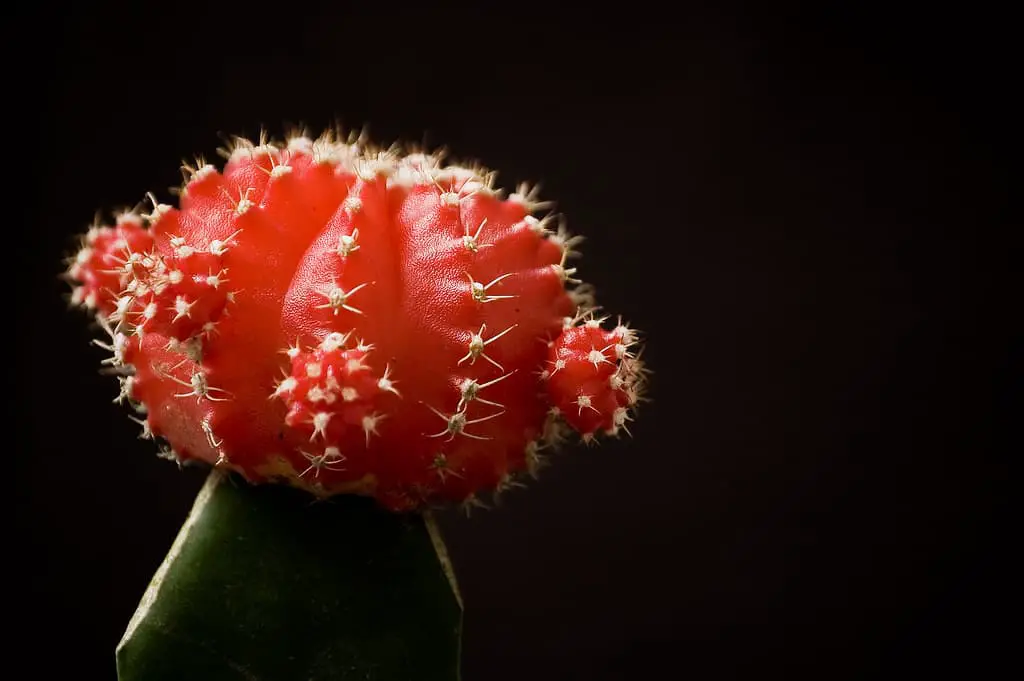The Moon Cactus, which is also known as Ruby Ball Cactus, is one of the most colorful cacti available. It is a good plant for new cactus/succulent growers because it grows well indoors and thrives on neglect. The Moon Cactus is unique because it is actually two succulents grafted together. So how do you care for a Moon Cactus?
To properly care for Moon Cactus, place it in bright shade. This plant will survive in low-light conditions, but direct sunlight will cause the vibrant colors to fade. In addition, water your Moon Cactus using the soak and dry method. Water the plant thoroughly and allow the soil to dry completely and remain dry for about a week before watering again.
The rest of this article will provide a more detailed description of the Moon Cactus and a discussion of the history behind this unique cactus. Finally, I will outline the care requirements for Moon Cactus.
About Moon Cactus
The Moon Cactus, which is also known as Ruby Ball Cactus, is a mutant Gymnocalycium mihanovichii grafted onto a Hylocereus cactus.

Gymnocalycium mihanovichii 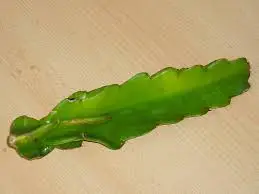
Hylocereus undatus
The colorful ball on top of a Moon Cactus (Gymnocalycium mihanovichii) is a type of cactus native to Paraguay and parts of Argentina. The specimens of Gymnocalycium mihanovichii that are used to make a Moon Cactus are actually mutants that do not have any chlorophyll. The lack of chlorophyll is responsible for the cacti’s bright colors as it exposes the red, yellow, or pink pigmentation.
Because the Gymnocalycium mihanovichii does not have chlorophyll, it cannot photosynthesize. It depends on the Hylocereus cactus for the nutrients necessary to survive. This means that if you remove an offshoot of the Gymnocalycium mihanovichii, it will not survive unless you graft it to another rootstock.
The “stem” of the Moon Cactus is usually Hylocereus undatus, which is commonly referred to as the White-Fleshed Pitahaya or Dragon Fruit Cactus. In the wild, this plant is a fast-growing epiphytic vine-like cactus. Although this plant’s native region is unknown, scientists believe it is Central America. Today, Dragon Fruit Cactus is grown as ornamental plants as well as fruit crops (dragon fruit) in tropical regions like Vietnam. Dragon Fruit Cactus also grows as an invasive species in Hawaii.
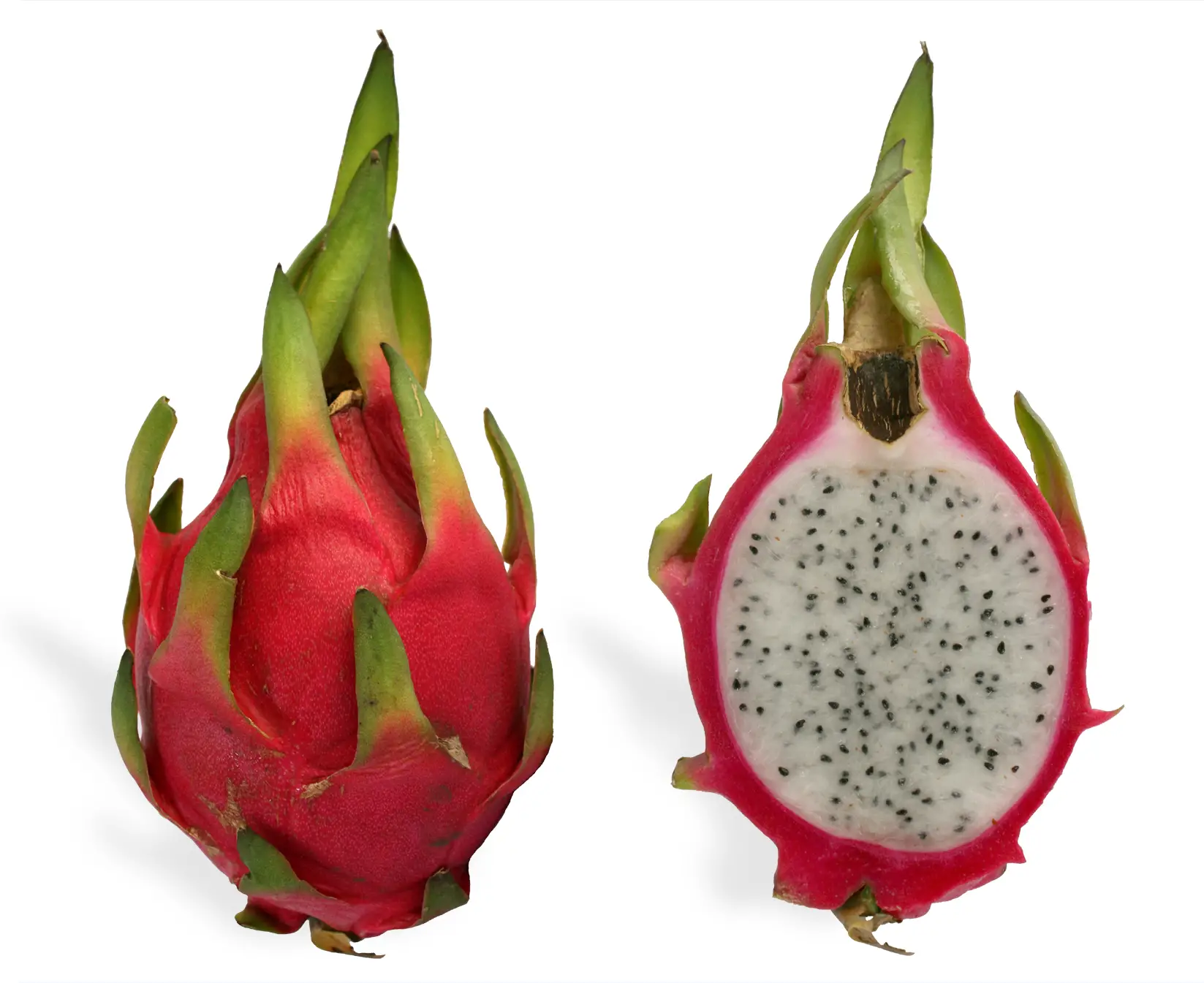
History
So you may be wondering who thought up the idea to graft one cactus to another. According to many sources, that person is Eiji Watanabe. Eiji Watanabe started developing the Moon Cactus during the 1930s. Watanabe ordered 300 Gymnocalycium mihanovichii var. friedrichii seeds from Germany in 1937 and allowed the plants to grow until they flowered. He then collected seeds from these cacti and used them to grow over 10,000 more Gymnocalycium mihanovichii var. friedrichii seedlings during 1940. Two of these plants mutated and had a red color. Watanabe grafted these cacti and continued to propagate the brightly-colored specimens. Eventually, he ended up with the Hibotan cultivar.

Some people believe Watanabe purchased these plants from a cactus specialist and started producing them himself rather than coming up with the original idea for the Moon Cactus.
These cacti were introduced to the United States and Europe during the 1960s, but they were never very popular with cactus collectors. However, they were introduced to the general masses in the 1980s and exploded in popularity. Today, over 70% of these cacti are produced in South Korea.
Flowering
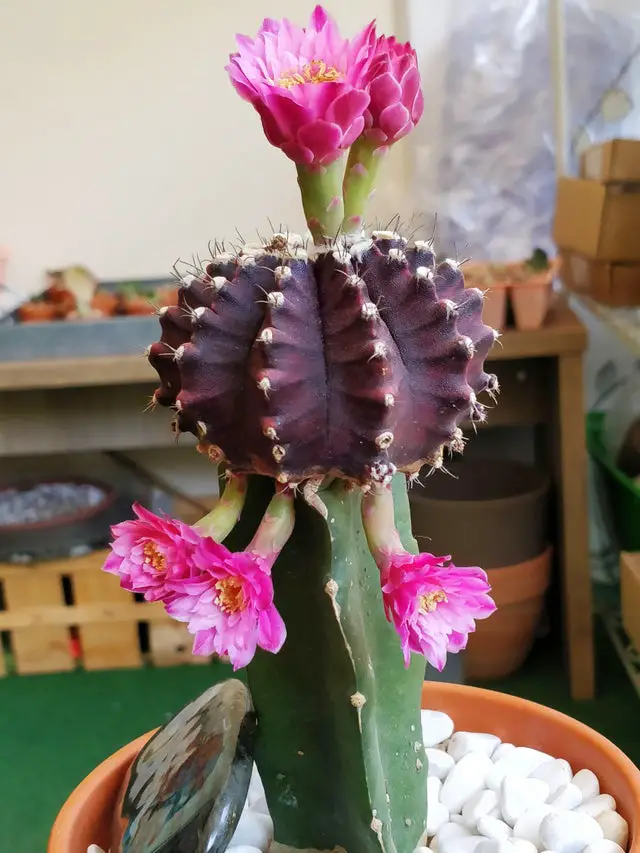
Source: Reddit User kittysuccs
With proper care, the Moon Cactus will bloom in the late spring or early summer. Unfortunately, it is rare for Moon Cactus to flower indoors.
Lighting
Like all cacti, the Moon Cactus needs to be exposed to light in order for the Hylocereus undatus to photosynthesize and keep the grafted cactus alive. The Moon Cactus will grow best when exposed to bright shade. They should not be placed in a spot that receives bright, direct sunlight. This will cause the coloring to fade. If you are growing this plant indoors, it will do best when placed a couple of feet from a sunny window.
Although Moon Cactus does best in bright shade, but they will survive in low-light conditions. A girl at my work has had a Moon Cactus sitting on her desk for over a year, and it still looks good even though it has not been exposed to any natural sunlight – just fluorescent office lighting.
Watering Your Moon Cactus
Because it is a grafted cactus, the Moon Cactus is more susceptible to root rot than other types of succulents. For this reason, it is best to err on the side of underwatering. I only water my Moon Cactus once a month during the summer and once every two months during the cooler months.
The best method for watering your Moon Cactus is to use the soak and dry method. Soak the soil thoroughly. Then allow the soil to dry out completely and remain dry for about a week before watering again.
To avoid overwatering, it is important to plant your Moon Cactus in a pot that has drainage holes. This will allow excess water to flow out of the soil.
Soil
Dragon Fruit Cactus, which forms the base of Moon Cactus, grows epiphytically (without soil) in nature. Like most epiphytes, the Moon Cactus grows best in well-draining soil. Although these plants will do okay in a commercially available potting soil mix for cacti, it is better to add perlite, coarse sand, or lightweight expanded clay aggregates (LECA) to improve drainage and minimize the chance of root rot.
Temperature
Moon Cacti should be kept in a location where temperatures will be above 60°F at all times. They can be kept outside during the warmer months, but it is best to bring them indoors during the winter. These plants are not frost tolerant.
How to Graft Cacti
If the bottom portion of the Moon Cactus begins to get sick or unhealthy looking, you can try grafting the top portion to another cactus. This section will outline the steps for grafting cacti. It sounds like a scary process, but grafting is not a terribly difficult process.
Materials
- Grafting knife or another sharp knife that is not serrated
- Leather gloves
- Rubber bands/twine
Steps
Step 1: Cut the head off of the rootstock (the bottom cactus). You will want the rootstock to be at least 3-4 inches above the soil surface.
Step 2: Secure the graft by putting a rubber band or twine around the whole cactus. Do not worry about hurting the cactus with too much pressure. After a couple of weeks, the two cactus will be bonded together permanently.

Why does my Moon Cactus have black spots?

If you see black spots forming on your Moon Cactus, it is probably rotting from the base of the plant up into the top portion (Gymnocalycium mihanovichii) of the plant. Unfortunately, black spots are an indication that the plant is moribund and cannot be saved.
Why does my Moon Cactus look deflated?
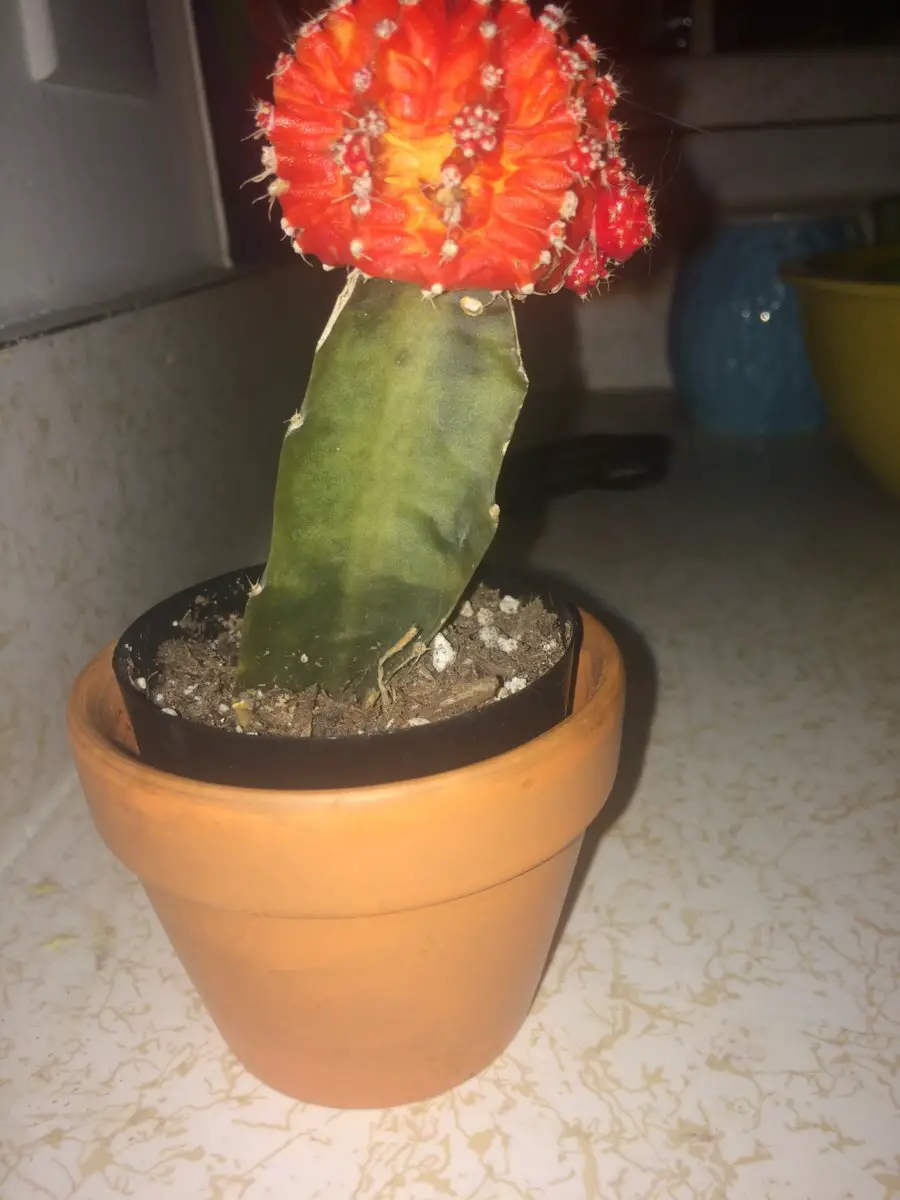
The most likely reason that the Moon Cactus will begin to look deflated and thin is overwatering. Overwatering is the most common problem associated with the Moon Cactus. As the Moon Cactus is comprised of desert plants, these cacti can survive prolong periods of drought. For this reason, it is better to err on the side of underwatering your Moon Cactus.

